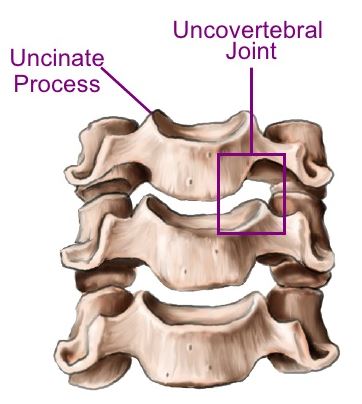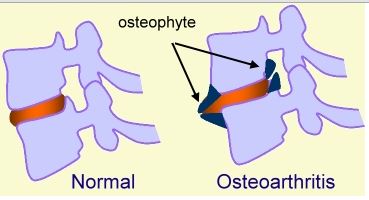Uncovertebral Joint
Anatomy of Uncovertebral Joint
Human vertebral column has 33 bones and the first segment is called cervical region. There are seven cervical vertebrae and first two are immovable. Uncovertebral joint is present from cervical 3 to cervical 7 vertebrae. They arranged with one another by parallel sequence and lie at the lateral boundaries of the cervical vertebrae.
The five hoarded neck spine are associated with four cartilage-covered joints – a couple of facet joints situated on the articular processes on any side, and a couple of uncovertebral joints produced where minute ridges of bone, called the uncinate processes, mount up the top rim of the cylindrical vertebrae. The joints are shaped between uncinate process and uncus. Uncinate process is the upward projections of cervical vertebrae and uncus is the downward projections.

Image 1 : Uncovertebral Joint
The uncinate process and its related uncovertebral joint provide unique features to the cervical spine. They are uncontroversial joint and also termed as Luschka joint. At the time of birth, this joint is underdeveloped and with increase of age this gets developed. They appears as similar as bony ridge and forms articulation with each other and provide stability in the lateral portion of the neck.
Movement of Uncovertebral Joint
Uncovertebral joints permit for flexion and extension and bound lateral flexion in the cervical vertebrae.
Flexion: Bending movement from a certain joint where angular distance is reduced.
Extension: Stretching movement from a certain joint where angular distance is increased.

Image 2: Movement of Uncovertebral Joint.
The rotating axis is located at the bottom of the disk; at the uncovertebral joint. Functional disc deformation is common due to the movement of flexion and extension which gives outcome of translator movement between adjacent vertebrae. The distance between two vertebral bodies is smallest because of the vertical position of the uncinate process, but for rotation the distance to axis is largest.
Functions
- Uncovertebral joints posterior-laterally supports the intervertebral disc, resultant that gives protection for formation which is having risk of disc herniation.
- The posterior linear translation movement of the spine is prevented by Uncovertebral joints.
- Uncovertebral joints provide permanence and direct the movement of the cervical vertebrae.
- The uncovertebral joint slanders immediately behind, subsequentlly and medial to the spinal artery, delivering blood and oxygen to the posterior part of the brain.
Clinical Significance (pathology)
- With age, the vertebral disk become thinner this increases the load in uncovertebral joints. The most affected part is C5 and C6 segment, as the thinning is started from here due to the mobility rate is higher in this area.
- After the age of 60 years, the degeneration of spine is progressive. Medically it is termed as bone spurs or osteophytes. In osteophytes, the bone becomes enlarged from normal bony structure and look like parrot beak. This type of enlargement is easily marked in X-ray or MRI of the spinal cord.
- The development of osteophytes or bone spurs causes bone defeat, degeneration of disc and vertebral stability become weaken. In general, osteophytes do not have significant symptoms. The progression of osteophytes affects connected nerve roots which causes nerve compression and finally generates pain at the site and the pain is spread gradually to the spinal cord.

Image 3: Osteophytes in Uncovertebral Joint
4. Some individuals may also have muscle weakness, tingling and numbness on the affected area. Bone spurs originated at uncovertebral joints may develop a medical state which is termed as foraminal stenosis. It also provides the similar types of symptoms. Other than age, poor posture, injury can cause degeneration of spinal joints.
Treatment of Uncovertebral Joint Pain
General analgesic treatment can give relieve from pain and proper physical therapy also improve the condition. If the condition is persistent for long time, then surgical procedure help to rid off the pain.
In case of severe neck or head injury, it also affects the articulation of the spine and causes discs degeneration and sudden occurrence of torticollis. Torticollis disorder occurs in the neck muscle and exhibit abnormal flexion, extension and twisting of the muscle. In this condition, the movement of neck is restricted.
The opposite side of the affected muscle movement causes pain and affected muscle becomes swelled up. The available treatment options are physiotherapy, medical device application in physical therapy, stretching exercise, botulinum toxin administrations and surgical procedures.
References
- http://www.jblearning.com/samples/076375594X/55942_CH01_Vander.pdf
- http://www.physio-pedia.com/Uncovertebral_Joints
- http://www.ncbi.nlm.nih.gov/pubmed/24453021
- http://www.laserspineinstitute.com/back_problems/spinal_bone_spurs/joint_osteophytes/
- http://www.chiropractic-help.com/Uncovertebral-Joint-Luschka.html
